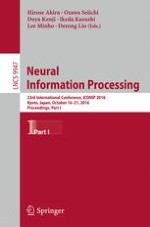The four volume set LNCS 9947, LNCS 9948, LNCS 9949, and LNCS 9950 constitutes the proceedings of the 23rd International Conference on Neural Information Processing, ICONIP 2016, held in Kyoto, Japan, in October 2016. The 296 full papers presented were carefully reviewed and selected from 431 submissions. The 4 volumes are organized in topical sections on deep and reinforcement learning; big data analysis; neural data analysis; robotics and control; bio-inspired/energy efficient information processing; whole brain architecture; neurodynamics; bioinformatics; biomedical engineering; data mining and cybersecurity workshop; machine learning; neuromorphic hardware; sensory perception; pattern recognition; social networks; brain-machine interface; computer vision; time series analysis; data-driven approach for extracting latent features; topological and graph based clustering methods; computational intelligence; data mining; deep neural networks; computational and cognitive neurosciences; theory and algorithms.
